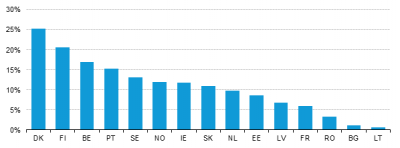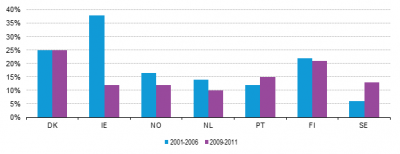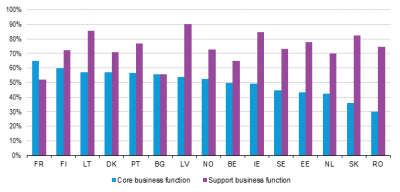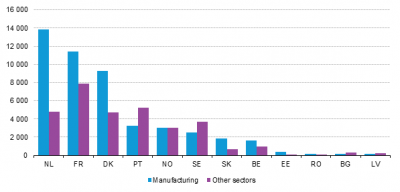- Data from June 2011. Most recent data: Further Eurostat information, Main tables and Database.
To stay competitive, enterprises increasingly organise their production globally, breaking up their value chains into smaller parts supplied by a growing number of providers located worldwide. International sourcing of business functions is a key feature as European businesses increasingly globalise their production processes. To find out more about this phenomenon, the new survey gathered data on international organisation and sourcing of business functions in 15 European countries. The survey results cover nearly 40 000 businesses each with more than 100 persons employed (see box on methodology for more details about the survey).
Main statistical findings
The survey revealed that for the period 2009 2011:
- The highest share of sourcing internationally is found in small, open economies with high labour costs.
- Sourcing is still mainly driven by manufacturing enterprises that are increasingly sourcing support business functions.
- The number of enterprises sourcing knowledge intensive support functions is growing.
- Proximity is a major factor in sourcing, with domestic sourcing being more prominent than international sourcing and with international sourcing mainly taking place within Europe.
- Direct employment consequences are limited but their cumulative and indirect effects should not be underestimated.
International sourcing prominent in small, open, high labour cost economies
The highest share of sourcing internationally is found in small, open economies with high labour costs (see Figure 1). The relatively high percentage of international sourcing found in Portugal seems not so much driven by labour costs as by the growth of the Brazilian economy which is an important market for Portuguese exports.
Moving business functions abroad varies between member states
The results from the first survey to monitor international sourcing patterns, covering the period from 2001 to 2006, showed that enterprises in Denmark and Finland were already using international sourcing as a business model quite extensively. For countries that took part in both surveys, the economic and financial crisis seems to have influenced patterns of sourcing behaviour differently (see Figure 2)[1] . Enterprises in the Netherlands and Ireland reduced international sourcing, while in Denmark and Finland, the pattern stayed consistent, though the new survey covers only three years, while the previous one covered six. In Sweden and Portugal, there was a rise in the proportion of businesses that opted for international sourcing, even over the years 2009-2011, compared to the previous six-year period. Thus, the survey results show that the economic crisis did not result in clear and unambiguous pattern of effects as regards international sourcing.
Manufacturing leads international sourcing
Manufacturing drives international sourcing. In many countries, around two-thirds of all enterprises sourcing internationally are in the manufacturing sector, with a third in other sectors, such as services. France and Estonia reported particularly low levels of sourcing for other sectors.Denmark has the most frequent incidence of international sourcing in manufacturing (34 % of all manufacturing enterprises with 100 or more persons employed), followed by Finland (29 %) and Belgium (22 %), (see Figure 3). In the new member states, only a few manufacturing enterprises are involved in international sourcing, with the exception of Estonia. Again, the pattern in France is different to that in other old member states, with a relatively low proportion of international sourcing for manufacturing.
Most European enterprises source domestically
Even though European businesses do use some international sourcing, they still apply the business model of sourcing core or support functions within their countries, rather than internationally. This is the case for all countries that took part in the survey, except for Belgium and Sweden. Domestic sourcing is much more frequent than international sourcing, especially in new member states, but also in Finland (see Figure 4).
Support business functions frequently moved abroad
Enterprises were asked to divide their functions into core (mainly their main activity) and support functions (service functions for internal use). International sourcing was originally a model used by manufacturing enterprises to move their production abroad, but with the growth of digitalisation and codification of services, the sourcing model has expanded to service functions and services enterprises too. In relative terms, surprisingly, France had the biggest proportion of enterprises sourcing their core function internationally. Sourcing of core functions — often in manufacturing — was also of relatively high importance in Finland, Lithuania, Denmark and Portugal (see Figure 5).
In general, businesses more frequently source support functions than core functions. Around 60% to 80% of businesses said they had sourced support functions. Only in France were core functions sourced more frequently. The importance of sourcing support functions is remarkable, taking into account that most sourcing enterprises are in manufacturing. This indicates that the pattern of international sourcing is changing from low-skilled production jobs in manufacturing to services, often performed by a more highly skilled work force.
ICT the most frequently sourced support function internationally
The survey identified several types of functions that support the core business function of an enterprise. These are distribution and logistics, marketing and sales, administration and management, ICT services, R&D and engineering.
The previous survey showed that ICT services were the most frequently sourced support function. This survey confirms this pattern, as roughly a third of enterprises reporting international sourcing had moved ICT functions abroad (see Figure 6). In Lithuania and Romania — the countries with the lowest proportion of enterprises sourcing business functions abroad — the proportion of enterprises sourcing ICT functions was highest (over 40 per cent). In contrast, in France, less than 20% of enterprises had moved ICT functions abroad between 2009 and 2011.
International sourcing of ICT should be seen in the context of other results from this survey, such as the dominance of multinational enterprises as actors in international sourcing, and the fact that such sourcing is often based on strategic decisions taken by the group head. ICT support functions can, due to the digital character of many of the services involved, be conducted relatively easily from any location, and this is supported by the general increase in the use of cloud computing.
Knowledge intensive support functions are often sourced globally
From a policy-making point of view, the relatively large share of businesses that have sourced their knowledge-intensive R&D and engineering functions abroad could be a worry, as the EU has a political focus on furthering R&D as part of the Europe 2020 strategy for European businesses to stay globally competitive. Typically, 15% to 20% of enterprises carrying out international sourcing are moving R&D and engineering functions abroad (see Figure 7), though it is important to emphasise that over half (53 %) of the international sourcing of R&D and engineering functions is being moved to other EU member states.
In a first wave, many manufacturing enterprises in old member states moved their core production functions to new member states. Interestingly, some member states report relatively high shares of R&D and engineering functions sourced abroad in the second wave. In contrast, these knowledge-intensive support functions are rarely moved abroad in the Netherlands and France.
Insourcing dominant due to multinational enterprises
Multinational enterprises are the drivers of globalisation and this is also the case with international sourcing. The survey distinguishes between international sourcing to a foreign affiliate or daughter company within the same multinational enterprise group — so-called insourcing — and sourcing to external providers, called outsourcing. Evidence for the key role of multinationals in international sourcing is supported by the fact that for most countries, 70% to 80% of sourcing enterprises are carrying out insourcing, while only 30% to 40% were outsourcing their business functions abroad (see Figure 8). Only in some of the new member states was outsourcing used by a majority of enterprises sourcing internationally. This can probably be explained to a large extent by the fact that few domestic enterprises in these countries are multinationals, and so have fewer opportunities to insource internationally.
Cost cutting drives international sourcing
In most countries, the main reason businesses moved functions abroad between 2009 and 2011 was to cut labour and other costs (see Figure 9). This was particularly important for enterprises in high labour costs countries, such as the Nordic countries. Finland, Denmark and Sweden topped the list of those citing cost cutting as the main reason for international sourcing, followed by Belgium, Ireland and Norway. These results confirm the pattern seen in 2001-2006, but interestingly, cutting labour costs was less important in many countries in the latest survey than it was in the previous one (Portugal, Norway, the Netherlands, Denmark and Ireland).
In contrast, Romania, Estonia, Portugal, and Latvia, with low labour costs, attach much less importance to cutting those costs when moving business functions abroad. For these countries, cutting other costs appeared to be a more important driver for international sourcing.
Group heads take strategic decisions on international sourcing
Multinational enterprises are driving the globalisation process also in terms of moving business functions abroad. The way they organise their global value chains is very important in achieving competitiveness, so strategic decisions on international sourcing are often made by global group heads and implemented by their foreign affiliates. In seven out of the 15 countries taking part in the survey, more than half the enterprises reported a strategic decision taken by the group head as a very important factor for international sourcing (see Figure 10). Access to new markets can influence the decision to relocate business functions, particularly for global enterprises. Often, access to new markets requires new or expanded activities abroad, — typically through existing or new affiliates. This is not counted as international sourcing, since no moving of business functions is involved (see methodological notes). So access to new markets is not ranked very high as a reason for moving business functions abroad. Roughly 10-20 per cent of enterprises cited access to new markets as a very important reason for international sourcing. Interestingly, Portuguese enterprises rank new markets very high, possibly driven by growth in Brazil, an obvious and historically important market (see Figure 11). Access to new markets was more important in the 2001-2006 survey (between 11% and 79 %, overall 37 %) than for 2009-2011 (between 5% and 55 %, overall 14 %), probably influenced by the global economic climate in these periods.
Co-location of functions matters
The survey also shed some light on the importance of physical integration of core and support business functions. The issue is whether highly skilled jobs in knowledge-intensive support functions would follow lower-skilled jobs in manufacturing in a second wave. As mentioned above, ICT functions have been the most intensively sourced support functions so far. Businesses rarely considered it important to have their ICT services based in the same place as core business functions. They see it as more important to have administrative and management functions located close to core business functions (see Figure 12). Though the pattern varies widely, there is a distinct tendency towards moving support functions abroad as a second wave of international sourcing.
International sourcing and employment development
By definition international sourcing implies job losses in the domestic economy. This causes concerns for policy makers in Europe. One of the purposes of the survey was to produce statistical evidence regarding the impact of international sourcing on employment.
Not surprisingly, enterprises that relocated functions abroad were more likely to report job cuts (55 %) than those that did not do so (27 %). In countries with higher labour costs enterprises that relocated business functions abroad report more job losses. In contrast, in countries with low labour costs, job losses were higher in enterprises that did not source internationally, with the exception of Slovakia and Lithuania (see Figure 13).
The survey also provided information on the number of jobs lost from 2009 to 2011 because business functions were relocated abroad. In total, the 11 countries for which data are available reported the loss of about 83 000 jobs between 2009 and 2011 in enterprises with 100 or more persons employed (see Figure 14). Not surprisingly, most of the job losses were in manufacturing. Only in Portugal, Sweden, Bulgaria and Latvia were more jobs lost in other sectors. France topped the list (with more than 19 000 jobs lost), followed by the Netherlands (nearly 19 000 jobs lost), and Denmark (nearly 14 000 jobs lost). In new member states with low levels of international sourcing, few jobs were lost due to this reason.
Job losses due to international sourcing in enterprises with 100 or more persons employed were relatively low for 2009-2011 (see Figure 15). Denmark reported by far the biggest job losses in relative terms, especially in manufacturing. More than 5% of jobs in Danish manufacturing were moved abroad in 2008. The Netherlands was the only other country experiencing significant job losses in relative terms because of international sourcing. International sourcing is a minor factor in explaining the huge rise in unemployment that Europe has experienced since the start of the economic crisis. However, the flow of jobs abroad is continuous, and the cumulative and indirect effects of this should not be underestimated.
Business functions mainly sourced within the EU
For most countries , EU member states are the primary destination for the international sourcing of core business functions. This seems to indicate that proximity is still an important factor when sourcing internationally (see Figure 16). When investigating international sourcing within the EU this proximity issue seems to be the cause for businesses in Portugal, Ireland and to a lesser extent France to source more to countries in the EU-15. Businesses in the other EU-15 countries, being closer to the Member States which joined the EU in 2004 and 2007 (EU-N12), source more to those countries. Other than that there is no clear pattern discernible for the sourcing of core business functions within the EU (see Figure 17). The relocation pattern for support business functions, on the other hand, seems rather similar in all participating countries. The countries in the EU-15 are clearly attracting support business functions such as services. The reason might be partly the location of a large number of group heads of multinational enterprises in the old member states, partly that other factors than reduction of labour costs are more dominant when deciding to move support functions abroad (see Figure 18).
China and India as sourcing destinations
China and India, two leading emerging economies, are both important locations for business functions sourced from the EU. They attract different types of business functions. Not surprisingly, China is strong in attracting core business functions, generally in manufacturing (see Figure 19). In Bulgaria, Finland, France, Ireland and Norway, at least 20% of enterprises sourcing core functions abroad do so to China.
On the other hand, India is strong in supplying business support services globally. EU countries are more likely to source support functions to India than to China, especially France, Ireland and Finland (see Figure 20). The previous survey found a similar pattern.
Data sources and availability
The data presented in this article are from a survey on "International organisation and sourcing of business activities". The data, which cover the period 2009-2011, has been collected in 15 countries:
- Belgium
- Bulgaria
- Denmark
- Estonia
- Ireland
- France
- Latvia
- Lithuania
- the Netherlands
- Portugal
- Romania
- Slovakia
- Finland
- Sweden
- Norway.
The international sourcing statistics cover NACE Rev.2 (Statistical Classification of Economic Activities in the European Community) sections B to E and F to N excluding K which, broadly speaking, cover Non-financial market activities. The data refers to enterprises with 100 or more employees.
Further Eurostat information
Publications
- Global Value Chains and Economic Globalization - Towards a New Measurement Framework - Dr. Timothy J. Sturgeon, Industrial Performance Center, MIT
- http://www.youtube.com/watch?v=2DV78MnHtQI - Youtube video of Eurostat Seminar on the measurement of Global Value Chains and Economic Globalisation
- http://www.cso.ie/en/newsandevents/conferencesseminars/eurostatseminarglobalvaluechainsandeconomicglobalizationtheeurostatinitiative - Details of the Seminar mentioned above
- International Sourcing in Europe - Statistics in focus 4/2009
- Features of International Sourcing in Europe in 2001-2006 - Statistics in focus 73/2009
- Plans for International Sourcing in Europe in 2007-2009 Statistics in focus 74/2009
Database
Dedicated section
Methodology / Metadata
- International sourcing statistics - all activities (ESMS metadata file - iss_esms)
- Structural Business Statistics (ESMS metadata file - sbs_esms)
See also
Notes
- Caution is advised when comparing and interpreting results in terms of frequency of international sourcing from the two different surveys since they covered different timeframes. The first survey covered six years from 2001 to 2006, whereas the second survey covered only three years from 2009 to 2011. ↑




















